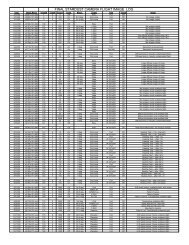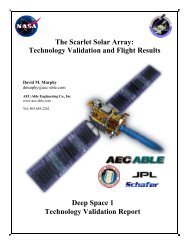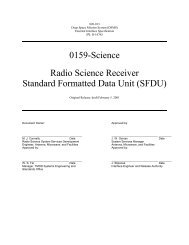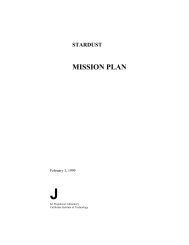PDS_VERSION_ID= PDS3 - PDS Small Bodies Node
PDS_VERSION_ID= PDS3 - PDS Small Bodies Node
PDS_VERSION_ID= PDS3 - PDS Small Bodies Node
Create successful ePaper yourself
Turn your PDF publications into a flip-book with our unique Google optimized e-Paper software.
STOP_TIME<br />
The STOP_TIME element provides the date and time of the end of an observation<br />
or event (whether it be a spacecraft, ground-based, or system event) in UTC<br />
system format. Formation rule: YYYY-MM-DDThh:mm:ss[.fff]<br />
SPACECRAFT_CLOCK_START_COUNT<br />
The SPACECRAFT_CLOCK_START_COUNT element provides the value of<br />
the spacecraft clock at the beginning of a time period of interest.<br />
SPACECRAFT_CLOCK_STOP_COUNT<br />
The SPACECRAFT_CLOCK_STOP_COUNT element provides the value of the<br />
spacecraft clock at the end of a time period of interest.<br />
DESCRIPTION:<br />
The DESCRIPTION element provides a free-form, unlimited-length character<br />
string that represents or gives an account of something.<br />
PROCESSING_HISTORY_TEXT<br />
The PROCESSING_HISTORY_TEXT element provides an entry for each<br />
processing step and program used in generating a particular data file.<br />
WAVELENGTH<br />
The WAVELENGTH element identifies the mean wavelength to which an<br />
instrument detector/filter combination is sensitive.<br />
B1950_RIGHT_ASCENSION<br />
The B1950_RIGHT_ASCENSION element provides the right ascension of a star<br />
or other object using the B1950 coordinate frame rather than the J2000 frame.<br />
B1950_DECLINATION<br />
The B1950_declination element provides the declination of a star or other object<br />
using the B1950 coordinate frame rather than the J2000 frame.<br />
MEAN_OBSERVATION_TIME<br />
The MEAN_OBSERVATION_TIME is the average date and time associated<br />
with an observation that itself consists of recording multiple events (photon<br />
arrival times, for example). It is distinct from OBSERVATION_TIME, which is<br />
the midpoint of the observation period, in that it is calculated by taking the<br />
arithmetic average of all event times associated with the single observation. For<br />
IRAS Additional Observation (AO) images, this is the observing time spent on<br />
the target. The rest of the time was used to make fine attitude updates on<br />
reference stars at the beginning and at the end of an AO. See also<br />
EXPOSURE_DURATION.<br />
SOLAR_ELONGATION






